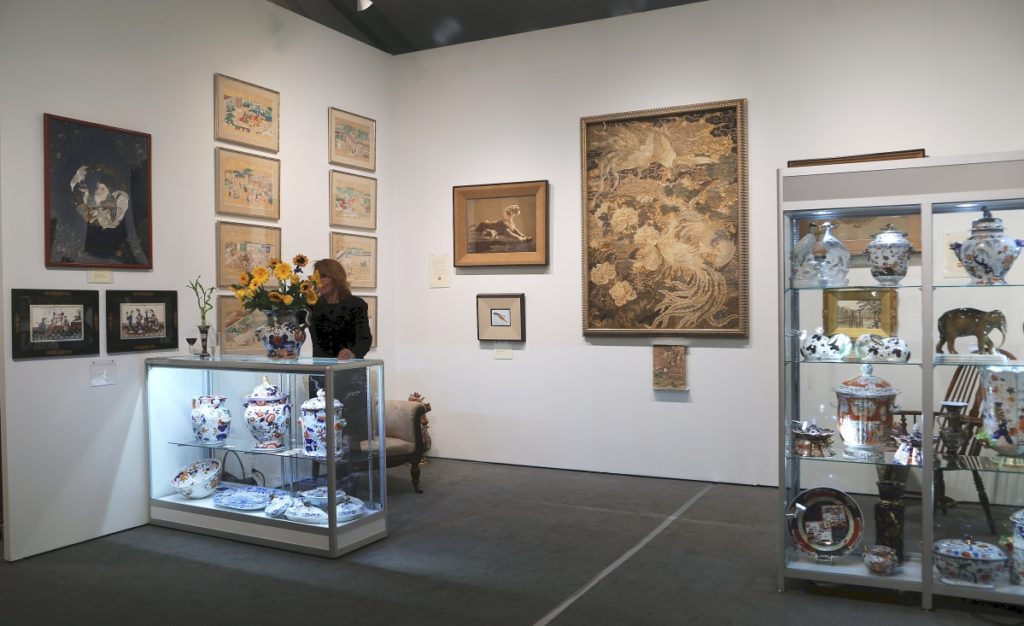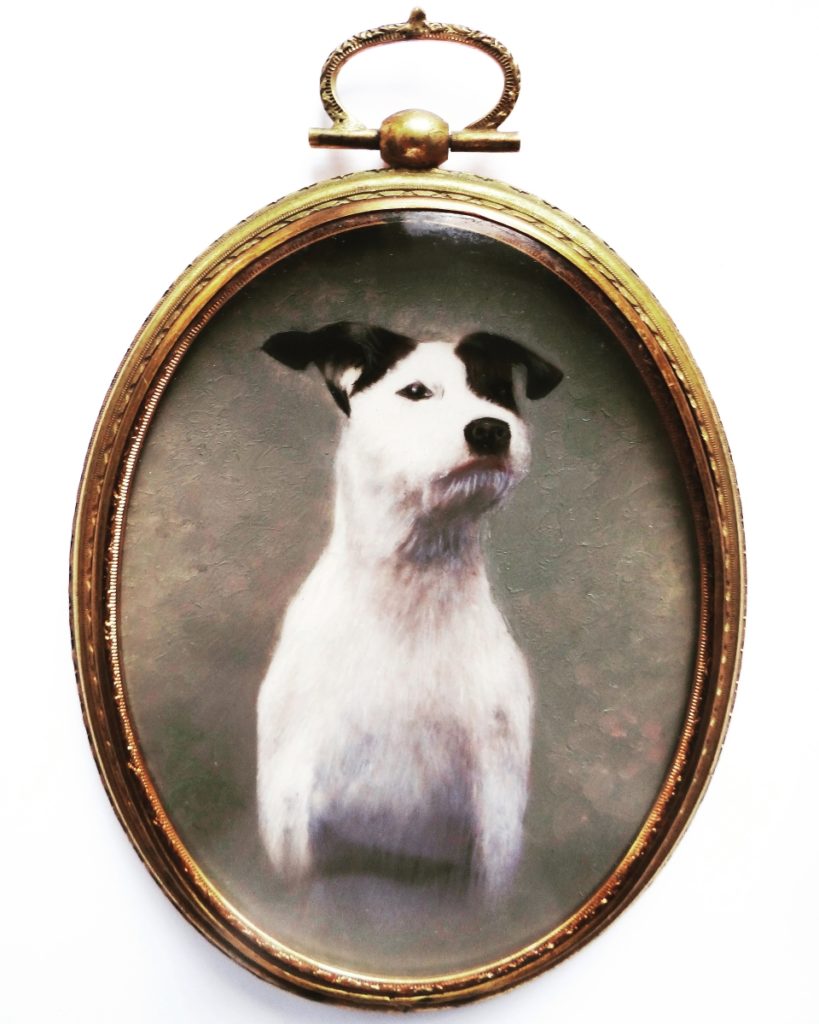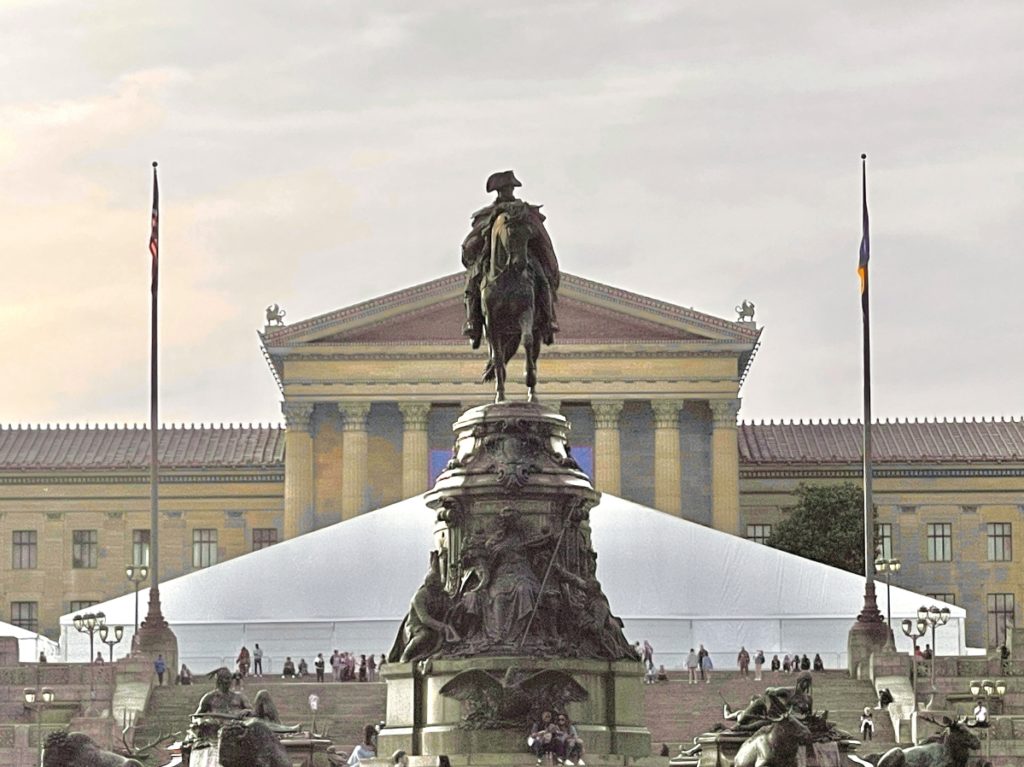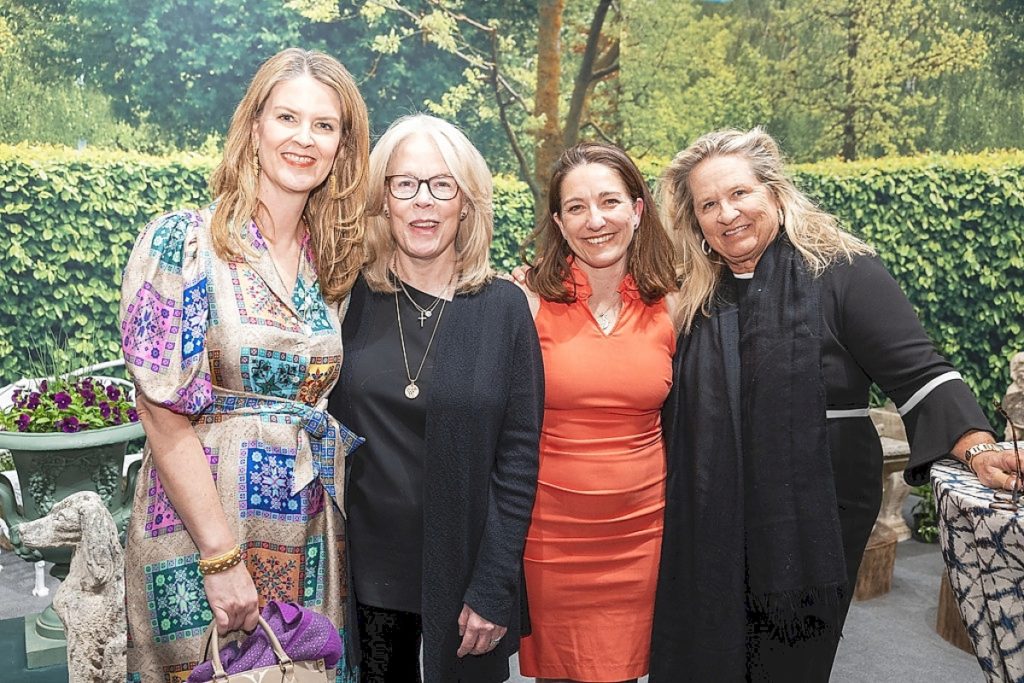
The Philadelphia Show set up on the East Terrace of the Philadelphia Museum of Art. Photo by Dan Burke Photo & Video, LLC.
Review and Onsite Photos by Madelia Hickman Ring
PHILADELPHIA – The Philadelphia Show has come home. For the first time since 2018, when the show has benefitted the Philadelphia Museum of Art’s division of digital resources and content strategy, it now takes place on the museum’s campus, in a large spacious white tent prominently situated on the museum’s East Terrace and at the top of the steps Rocky Balboa, played by Sylvester Stallone, jogged triumphantly up in the movie Rocky.
Formally known as The Philadelphia Show: Antiques, Art, Design, the event, which was open Friday-Sunday, April 29-May 1 after a preview party the night of Thursday, April 28, fielded 42 dealers, a reduced group from the 62 exhibitors that participated in 2019.
-1024x576.jpg)
Sales with Barbara Israel Garden Antiques included the small lamb partially shown on the very left side of this photo and four balls, seen center. Katonah, N.Y.
“It went really well. People are pleased. Dealers are pleased,” show manager Huntley Platt told Antiques and The Arts Weekly on Friday, April 29. “When you inherit a show, there’s so much built in, so many supporters and volunteers. You’re given a lot with that inheritance so putting a new and fresh spin on it was an exciting challenge. The mood on opening night was joyous. Infectious. Everyone was having a great time. There were a lot of sales; I was thrilled to see so many red dots.”
Platt said one of the biggest challenges with the new location was having to accommodate the large fountain that occupies the center of the museum’s east terrace. The solution invented and engineered by Platt’s site manager, Space Productions, was to create a raised central platform over the fountain within the tent. The result added a dimension to the show floor that created a dynamic floor plan and great flow.
About 2,000 people visited the show, a number, Platt said, that was similar to those who turned out for the last live edition when the show was at Philadelphia’s Navy Yard.
-1024x669.jpg)
Reportedly the only dealer on the show to have exhibited continuously since it began was Philip Bradley Antiques. To celebrate that, Lisa Minardi Bradley dug into the firm’s archives and retrieved photos of works that had previously graced the show floor. Sumneytown, Penn.
“People are still a little hesitant to come out and congregate, because of Covid,” Platt said when we reached her after the show. “A lot of people said they sold to younger buyers, as well as new clients. The new location will help with that, and we will work on cultivating them, too.”
When asked if there was constructive criticism that she would look to make changes around in 2023, Platt said there were some logistical issues, like clarifying parking and how to get into the show, which proved a bit challenging to visitors unfamiliar with the museum.
Eleanore “Lynn” Gadsden, co-chair of the show committee, said, “We were thrilled with the response of the dealers and the public and are so grateful to our corporate and individual donors who made such a beautiful show possible. We are looking forward to next year.”
-1024x576.jpg)
Diana H. Bittel Antiques, Bryn Mawn, Penn.
The loan exhibition, “Zero to 60,” celebrated the age milestone and highlighted loan exhibits from previous years. A still life that had been on the cover of the 1995 catalog when the theme was “Cook’s Fancy,” was on view, as was a pair of dalmatians that had graced the cover of the 2004’s show’s catalog the year the focus was “Folk Art on Fire.” Others were more in the spirit of previous loan exhibits, such as hooked rugs and portrait miniatures.
Even with a significantly smaller group of vendors, the show still welcomed four to the show; these were ones who had committed to the 2020 show that had to be cancelled last minute because of Covid-19 closures. Namely: Dixon Hall Fine Art, Phoenixville, Penn.; Gratz Gallery and Conservation Studio, Doylestown, Penn.; Glen Leroux Antiques, Westport, Conn.; and Schmidt/Dean, Cherry Hill, N.J.
Audrey Hall with Dixon Hall said the show went well and was well attended. She reported sales of several paintings, including a Henry McCarter (Pennsylvania, 1866-1942) pastel landscape to a local museum.

One of the deals closed with Betty Krulik Fine Art was “At the Battery, NYC” by John Marin (American, 1870-1953), circa 1930, graphite on paper 7¼ by 8-7/8 inches. The work had been both exhibited and published and Krulik sold it to a private Mid-Atlantic couple who have been regulars at the fair. Photo courtesy Betty Krulik, Irvington, N.Y.
Stephanie Lisle at Gratz Gallery said they had participated in the two online editions and were very excited to be there in person. She thought the show looked beautiful and that the organizers did an amazing job. They sold four small works – of six showed – by local living artist, Michele Krauss, and a large work by Leonard Nelson to an interior designer.
“It was very good. I did well and I was happy,” said Glen Leroux, who reported several new clients as well as sales of a pair of chairs, a table and some jewelry.
Christopher Schmidt, Schmidt/Dean, said that it was a beautifully done fair, one of the best they’d ever done. Though he acknowledged their contemporary offerings made them an “odd duck out,” they sold enough paintings and photographs to cover their expenses
The only dealer who has been exhibiting at The Philadelphia Show for the entirety of its run is Philip Bradley Antiques, now expertly steered by Lisa Minardi Bradley, Philip’s widow. To celebrate all 60 years of the firm’s participation in the show, Minardi dug deep into the company’s archives and hung on the outside wall of her booth black and white photos of highlights from previous shows.

Janice Paull, Greenville, Del.
“I thought the show looked terrific in the new location and there was good traffic all weekend – both familiar faces and new ones, including a lot of young people,” Minardi said. “I had several sales, including the Chester County tall chest formerly in the du Pont collection, a fraktur and a Berks County landscape. I also had strong interest in several other pieces that may result in additional sales.”
Farther down the same aisle, H.L. “Skip” Chalfant said that he’d been doing the show for all 60 years, though part of that was when he was working for Philip Bradley Antiques. Chalfant thought that people were anxious to buy and reported a “great show.” He sold a Philadelphia marble top pier table, a corner cupboard, a Kentucky rifle, a little bureau, a George Cope painting, some porcelain and a large landscape that went to a buyer “down south.”
Another dealer who sold furniture was Frank Levy, who reported selling five pieces of furniture to five different clients. He commented that it was “a great show with a very enthusiastic and educated crowd. The new location is perfect, and I think this is a show with a great history and a very promising future.”

One of the handful of sales made by Elle Shushan on opening night was this circa 1910 English school oval miniature of a Parson Russell terrier, on celluloid. Philadelphia
Arthur Liverant, riding shotgun home while Kevin Tulimieri was in the driver’s seat, has been doing the show since 1992 and had nothing but positive things to say about it.
“The show was terrific. We couldn’t be happier for the first year of what is basically a new show. Huntley Platt and her team did a fabulous job, and the Women’s Committee were terrific. They couldn’t have been nicer or more helpful. We were very pleased with the sales, the attendance and the enthusiasm of the people who came in.”
The Colchester, Conn., dealer reported several sales, including a serpentine-front cherrywood chest of drawers with a continuous apron and quarter-fan inlay on the drawer fronts, a newly discovered powder horn that commemorated the 1776 Battle of Harlem Heights, a late Nineteenth Century painting of an Oakland, Calif., family and their farmhouse, and several boxes that lined the outer wall of their corner booth.
-1024x610.jpg)
A hand-woven jute wall hanging by Louise Holeman Pierrucci, circa 1970, hung over David Secrest’s 1994 iron and steel “Ark Bench,” which was flanked on the left by a unique Harry Bertoia sound sculpture and on the right by a ceramic sculpture by Frederick Carlton Ball. Modern Gallery, Philadelphia
Across the aisle from Liverant, Pat Bell and Ed Hild, Olde Hope Antiques were busy selling. Bell reported sales of six items during the show and after it wrapped, they closed the deal on an important piece, with another two out on approval.
“We LOVED the show,” Bell enthused. “Most importantly it was clear that virtually everyone was thrilled with the new venue, both the structure and presentation of the show as well as the new location at the museum. The logistics for the dealers were very well handled and convenient, with a smooth load-in and move-out. There are always some details to work out, but all are minor in my opinion. If we can stoke the dealer roster with about six good dealers in American material, I think it would boost it considerably…Certainly, for visitors from out of town, the convenience is far better than the Navy Yard. In fact, I didn’t hear a single person say they disliked the move.”
Several red dots were spotted in the booth of Litchfield, Conn., dealer Jeffrey Tillou. Among pieces he sold during the show were a watch hutch, a Chippendale camelback sofa and a Chippendale tiger maple dressing table that was closely related to one referred to as a “masterpiece” by Albert Sack.
-1024x719.jpg)
Dolan-Maxwell, Philadelphia
Classical decorative arts specialist, Charles Clark, was situated adjacent to the raised center and made three sales during the show with additional sales from his Instagram posts. After the show closed, the Woodbury, Conn., dealer said he made two additional sales.
Also from Woodbury, David Schorsch was also positive in his opinion of the show, though he said he sold more things from the direct marketing he does than he did to people who came through the gate. His smaller items and paintings seemed to be more popular among shoppers and he sold a portrait of a young boy with a drum that also included the drum depicted in the painting. A young collector from New England who Schorsch had never worked with before purchased a theorem of seashells, and a small burl bowl also found a new home.
Across the aisle from Schorsch, Steven Powers was busiest on opening night but was optimistic he would have sales from follow up business. Towards the end of the preview party, red dots were spotted on a New England spoon rack, a work by Sister Gertrude Morgan and a carte de visite of Mrs Katie B. Robinson.

The Philadelphia Museum of Art’s East Terrace, facing Benjamin Franklin Parkway, was an ideal setting for the tent. In this photo, taken by Jeff Bridgman, it serves as a backdrop for the Washington Monument and fountain, 1897, which Bridgman thinks is one of the best pieces of statuary in the United States.
Kelly Kinzle was holding court just inside the entrance, in an emerald colored booth. Along the back wall was a monumental astronomical regulator with a case by George Jones for JS Townsend of Chicago. He also had a Chippendale cherrywood slab table with distinctive and very unusual blind pierced rails that dated to circa 1760 and which he had found in Pennsylvania.
Barbara Israel, situated opposite Kinzle on the other side of the entrance, had an extensive display and was happy to report a good show. Several red dots were spotted on opening night and after the event closed, she said she had sold some pairs of planters, four stone balls, a cast iron statue of Hebe on a base, a lamb, a badger and a dachshund, with a number of things with interest to follow up on.
Flag and folk art dealer Jeff Bridgman had an impressive display in a corner booth. Like many of the exhibitors, he was effusive in his praise of the show.

From left to right, show committee co-chair, Ellen Caplan, Anne Rubin, show manager Huntley Platt and Anne Hamilton, honorary chair. Photo by Dan Burke Photo & Video, LLC.
“I sold a number of flags, including one of my favorites in the booth, and an exceptional weathervane. I also bought well, and so was pleased with the show overall from those perspectives. The best thing about it was the location and the presentation. The show committee and the museum did a fabulous job of bringing the event, not just up a notch, but up a number of notches. It was a beautiful show, full of wonderful material, presented by top people in each field. The tent was formidable in its grandeur on the terrace, at the top of the steps…The location was terrific, the layout great, and the 12-foot walls really made it look fantastic.”
Sales of fine art, which often have a higher price point than many decorative works, can take longer to negotiate a sale so it was encouraging to see a good number of red dots on works of art.
“The response to The Philadelphia Show on the East Terrace of the PMA was overwhelmingly positive,” reported Ron Rumford, director of Philadelphia-based gallery Dolan/Maxwell. “We met many of our clients there and had sales for contemporary Irish artist, Michael Canning; and contemporary Philadelphia-based artist Steven Ford, which sold to new collectors.”
-1024x598.jpg)
Francis J. Purcell, Philadelphia
“There is also strong interest in our Modernist works by African American artist Norman Lewis and Beauford Delaney. We also showed an important group of oils by Nineteenth Century African American artists Robert Duncanson, Grafton Tyler Brown and Henry Ossawa Tanner, all of which drew good interest.”
“We are delighted [The Philadelphia Show] is live again and beautifully positioned on the Benjamin Franklin Parkway. As a result of the new location, we met a good number of Philadelphians new to the show who expressed interest in collecting.”
Betty Krulik, whose eponymous gallery operates out of Irvington, N.Y., was just as upbeat. “We have been really delighted with the new location and the construction of the walls and the tent. It’s very luxurious and it shows all of our art, design and antiques beautifully. This has been a game changer and we are so grateful to the museum, staff and the women’s committee for their support of this exhibition.”
Krulik commented on “very knowledgeable visitors,” and reported ongoing interest as well as selling several works, including a John Marin drawing of New York and a small portrait by William Merritt Chase.
-656x1024.jpg)
You could not miss this pair of four-light candelabra by Whiting, New York City, circa 1890, that were with Spencer Marks, Southampton, Mass.
Matthew Imberman, co-president of Kentshire, provided the following quote by email once the show wrapped:
“Kentshire was thrilled to return to The Philadelphia Show in person this year, and especially pleased with the new location at the Philadelphia Museum of Art. The synergy with the PMA was palpable, and the overall polish of the show and the flow of the floorplan have been greatly improved! We met a number of new clients and reconnected with old friends. It was overall a successful show for us and we feel the show has found its perfect home at the PMA…We extend our extreme gratitude to all of the organizers and volunteers who made it such a smooth and successful show.”
The New York City dealer reported several sales, most notably a trio of gem-set antique bangles from Froment-Meurice; an important antique gold torque necklace by Michelsen of Copenhagen made to celebrate the suite of jewelry given to Princess Alexandra on the occasion of her marriage to Prince Albert of Wales in 1863; as well as an antique Austro-Hungarian gold bracelet.
James McConnaughy of S.J. Shrubsole pointed out several rare pieces of silver, including some early Sixteenth Century apostle spoons and a salver that had belonged to William Pitt the Younger (1759-1806).
-1024x652.jpg)
Frida Hansen’s “Southward,” woven in Norway circa 1900, had been discovered in Maine by Peter Pap. It rightfully attracted a lot of attention at the show. Peter Pap Oriental Rugs, San Francisco
In an airy booth near a side entrance, Jasmine and Thierry Doussiere, Silver Art by D&R pointed out several highlights in their display, including a Paul Emile Pissarro (1884-1972) landscape and a suite of four French candelabra by André Aucoc. After the show, Jasmine was happy to report that The Philadelphia Show was good for them.
“We thought the look of the show was great, and all the dealers had really set up a wonderful display. The location was also lovely of course. We met quite a few new clients, and there was a lot of interest in the antique French silver that resulted in sales. That also was the case for the drawings and paintings. We also had some clients of ours that came to visit and buy from New York and even Connecticut. All in all, the show was a success on our end, and we were delighted to be part of it! We look forward to next year!”
According to Janice Paull, Philadelphia was, in 1915, the first place in the United States where Japanese embroideries had ever been exhibited. To honor that history, she lined her walls with framed embroideries of every size and scale. The central focus of her booth was a Meiji period Japanese embroidery that she had acquired from a private collection that was sculptural in execution and depicted birds in a foliated landscape.
Ralph M. Chait Galleries was one of just a few dealers who had Chinese inventory. Both Stephen and Andrew Chait said they were very pleased with the look of the show and thought there had been strong attendance for the preview party and throughout the show. They reported particular interest in various Qing ceramics. When asked what their personal favorite pieces were, Andrew pointed out a pair of Kangxi famille verte vases while Stephen preferred a large Japanese Imari charger.
Peter Pap was the only rug dealer on the floor and was one of the few dealers who were situated on the central raised dais. One of the most striking works in his booth was a Sorover tapestry made by Frida Hansen, titled “Southward,” which had been woven in Norway circa 1900. Pap had discovered the approximately 10-by-12-foot tapestry, which was published in Scandinavian Design and The United States, in Maine. It featured ten red-headed maidens ride swans across a stylized Japonesque sea.
Dates for the 61st Philadelphia Show have not yet been announced.
For additional information, www.thephiladelphiashow.com.





.jpg)
.jpg)
.jpg)
.jpg)
.jpg)
.jpg)
.jpg)
.jpg)
.jpg)
.jpg)
.jpg)
.jpg)
.jpg)


.jpg)
.jpg)
.jpg)
.jpg)

.jpg)
.jpg)
.jpg)
.jpg)
.jpg)

.jpg)
.jpg)


.jpg)
.jpg)
.jpg)

.jpg)
.jpg)
.jpg)

.jpg)

.jpg)
.jpg)
.jpg)
.jpg)
.jpg)
.jpg)

.jpg)



